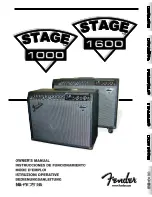
ELC-03XS User Manual
_________________________________________________________________________________________________________________
___________________________________________________________________________
version 2.2
page 31
8.3. Extracellular
Stimulation and Electroporation
Cells can be stimulated using current or voltage signals.
Stimulation with Current
Approach the cell in VC mode and apply square voltage pulses to the electrode.
Contact the cell, establish the loose-patch and disconnect the voltage signal from the
COMMAND INPUT :10 mV connector.
Set the MODE OF OPERATION switch to CC or CCx10.
Set the HOLDING CURRENT to zero.
For stimulation:
Apply the stimulus signal to the STIMULUS INPUT 1 nA/V connector.
or
Adjust the stimulus amplitude with the HOLDING CURRENT potentiometer and set the
stimulus polarity using the switch aside. Gate the preset stimulus with a TTL signal linked
to the GATE TTL BNC connector.
Electroporation with Current
Electroporation can be done using the stimulation procedure, but usually the applied current is
much higher and the stimulus duration is shorter. Therefore, most electroporation experiments
are done in CCx10 mode.
Stimulation with Voltage
Approach the cell in VC mode and apply square voltage pulses to the electrode.
Contact the cell and establish the loose-patch.
For stimulation apply a voltage signal of the required amplitude and duration to the
COMMAND INPUT :10 mV connector.
or
Adjust the stimulus amplitude with the HOLDING POTENTIAL potentiometer and set
the stimulus polarity using the switch aside. Gate the preset stimulus with a TTL signal
linked to the GATE TTL BNC connector.
Electroporation with Voltage
Electroporation can be done using the stimulation procedure, but usually the applied voltage
is much higher and the stimulus duration is shorter. For stimuli with large amplitudes set the
MODE OF OPERATION switch to VCx10 enabling electroporation with up to 12 V.







































